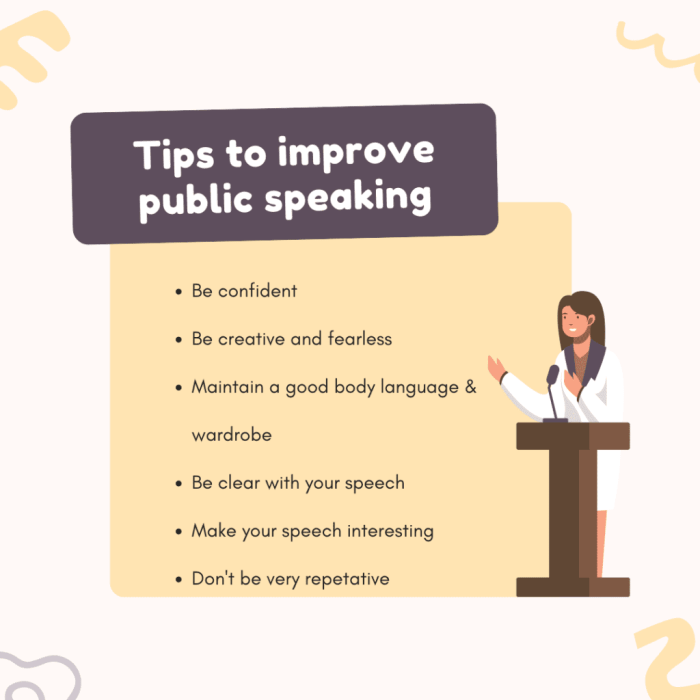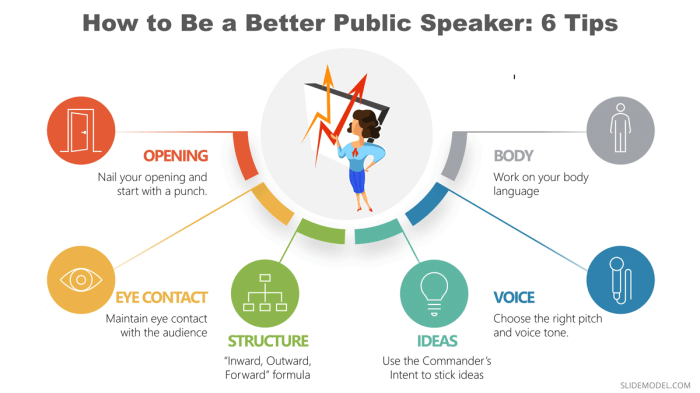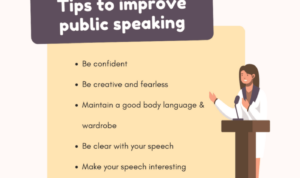Public Speaking Tips: Master the Art of Public Speaking with Confidence draws you into the world of effective communication, offering invaluable insights to enhance your speaking skills and captivate any audience. Dive in and discover the secrets to becoming a charismatic speaker!
Introduction to Public Speaking
Public speaking is the art of communicating information to an audience verbally. It involves delivering a message effectively, engaging the listeners, and conveying ideas clearly and persuasively.
Why Public Speaking Skills are Important
Public speaking skills are essential in various aspects of life, including academic, professional, and personal settings. Here are some reasons why honing these skills is crucial:
- Enhanced Communication: Public speaking improves your ability to articulate thoughts and ideas clearly, leading to better communication overall.
- Boosts Confidence: Speaking in front of an audience helps build self-confidence and assertiveness, which are valuable traits in any situation.
- Career Advancement: Effective public speakers are often perceived as more competent and trustworthy, which can open up opportunities for career growth and advancement.
- Influence and Persuasion: Mastering public speaking allows you to influence and persuade others, whether in a business presentation, a sales pitch, or a motivational speech.
- Networking: Being a skilled public speaker can help you network effectively, as people are drawn to those who can communicate their ideas persuasively.
Overcoming Public Speaking Anxiety

Public speaking anxiety is a common issue that many people face when speaking in front of an audience. The fear of judgment, making mistakes, or forgetting what to say can cause stress and nervousness. However, there are practical tips and relaxation techniques that can help manage and reduce anxiety before speaking.
Common Causes of Public Speaking Anxiety
- Feeling of being judged by the audience
- Fear of making mistakes or forgetting what to say
- Pressure to perform well and meet expectations
- Low self-confidence and negative self-talk
Practical Tips to Manage Anxiety
- Practice your speech multiple times to build confidence
- Familiarize yourself with the speaking venue to reduce uncertainty
- Breathe deeply and slowly to calm nerves before speaking
- Focus on the message you want to convey rather than on yourself
Relaxation Techniques to Calm Nerves
- Try progressive muscle relaxation by tensing and releasing different muscle groups
- Practice mindfulness and meditation to stay present and focused
- Visualize a successful speech and positive outcomes to boost confidence
- Use positive affirmations to combat negative thoughts and self-doubt
Effective Speech Preparation
When it comes to giving a killer speech, preparation is key. It’s like studying for a major test – you gotta put in the work to get those A+ results. Here’s how you can nail your speech prep game like a pro:
Researching the Topic Thoroughly
Before you even think about opening your mouth to speak, you need to do your homework. Dive deep into the topic like you’re searching for hidden treasure. The more you know, the more confident you’ll feel when it’s showtime.
Organizing Speech Content in a Coherent Manner
Just like a well-organized closet, your speech should have a clear structure. Start with a strong opening, followed by main points supported by facts or anecdotes, and wrap it up with a powerful conclusion. Think of it as a roadmap for your audience to follow along smoothly.
Engaging the Audience: Public Speaking Tips
Engaging the audience is crucial for a successful public speaking experience. It involves capturing their attention from the start and maintaining it throughout your speech. One way to do this is by using interactive techniques that encourage participation and keep the audience involved. Visual aids can also play a significant role in enhancing audience engagement by providing a visual representation of your key points.
Interactive Techniques
- Ask open-ended questions to encourage audience participation and interaction.
- Encourage audience members to share their personal experiences related to the topic.
- Use props or demonstrations to make your speech more dynamic and memorable.
- Incorporate group activities or small discussions to break up the monotony of a long speech.
Visual Aids for Engagement
- Use slides or multimedia presentations to visually represent complex information or data.
- Include images, graphs, or charts to help illustrate your key points and make them more easily understandable.
- Utilize props or physical objects that the audience can see and touch to create a more interactive experience.
- Incorporate videos or animations to add a dynamic element to your speech and capture the audience’s attention.
Improving Verbal Delivery
When it comes to public speaking, verbal delivery plays a crucial role in engaging your audience and conveying your message effectively. By working on your vocal variety, tone, pacing, pausing, and storytelling skills, you can elevate your speech to the next level.
Tips for Improving Vocal Variety and Tone
- Experiment with different pitch levels to avoid monotony and keep your audience interested.
- Use volume strategically to emphasize key points and maintain the audience’s attention.
- Incorporate pauses to create suspense and allow important ideas to sink in.
- Practice modulation to convey emotions and connect with your listeners on a deeper level.
The Significance of Pacing and Pausing
- Pacing helps control the speed of your speech, ensuring clarity and understanding for your audience.
- Strategic pauses can add emphasis, give your audience time to process information, and build anticipation.
- Mastering the balance between pacing and pausing enhances the overall impact of your speech.
Guidance on Using Storytelling
- Stories create a powerful emotional connection with your audience, making your speech memorable and relatable.
- Incorporate personal anecdotes or relevant narratives to illustrate key points and capture attention.
- Use descriptive language, vivid imagery, and a compelling narrative arc to engage and captivate your listeners.
- Practice storytelling techniques to enhance the delivery of your speech and leave a lasting impression.
Body Language and Nonverbal Communication

Body language plays a crucial role in public speaking as it can enhance or detract from the message being delivered. Nonverbal cues such as gestures, facial expressions, eye contact, and posture can greatly impact how the audience perceives the speaker and the credibility of the speech.
Importance of Body Language
- Body language can convey confidence, sincerity, and authority, making the speaker more engaging and persuasive.
- Poor body language, such as slouching, fidgeting, or avoiding eye contact, can undermine the speaker’s message and credibility.
- Awareness and control of body language can help the speaker establish rapport with the audience and maintain their attention.
Impact of Nonverbal Cues
- Facial expressions can convey emotions and reinforce the tone of the speech, helping to create a connection with the audience.
- Gestures can emphasize key points, add visual interest, and make the speech more dynamic and engaging.
- Eye contact can establish trust and show confidence, while lack of eye contact may signal nervousness or dishonesty.
Tips for Maintaining Confident Body Posture
- Stand tall with your shoulders back and head held high to project confidence and authority.
- Avoid crossing your arms or fidgeting, as these gestures can make you appear defensive or unsure.
- Make eye contact with different audience members to establish a connection and keep them engaged.
- Use purposeful gestures to emphasize key points and add energy to your speech.
Handling Q&A Sessions
When it comes to handling Q&A sessions after a speech, preparation is key. You want to make sure you are ready to respond to a variety of questions from the audience, whether they are straightforward or more challenging. Here are some strategies to effectively manage your Q&A session and ensure a smooth transition back to your main speech.
Strategies for Effective Q&A Management, Public Speaking Tips
- Carefully listen to each question before responding, ensuring you understand the question fully.
- Maintain eye contact with the audience member asking the question to show engagement and respect.
- Keep your responses concise and to the point, avoiding going off on tangents or providing unnecessary details.
- If you don’t know the answer to a question, it’s okay to admit it and offer to follow up with more information later.
Handling Challenging Questions
- Remain calm and composed when faced with a challenging question, taking a moment to gather your thoughts before responding.
- Acknowledge the question and address any valid points raised, even if you don’t fully agree with the premise.
- Avoid getting defensive or confrontational, instead, focus on providing a respectful and thoughtful response.
Transitioning Back to the Main Speech
- Signal the end of the Q&A session by thanking the audience for their questions and participation.
- Offer a brief recap of key points discussed during the Q&A session before smoothly transitioning back to your main speech topic.
- Use transitional phrases like “Now, moving on to our next topic…” to guide the audience back to the main focus of your presentation.
Virtual Public Speaking
In today’s digital age, virtual public speaking has become increasingly common. With the rise of online presentations and webinars, it is essential to adapt our public speaking skills to a virtual setting in order to effectively communicate our message to the audience.
Optimizing Lighting, Camera Angles, and Background
When speaking virtually, it is crucial to pay attention to your lighting, camera angles, and background to ensure a professional and engaging presentation.
- Optimize lighting by positioning yourself in front of natural light or using soft artificial lighting to avoid harsh shadows.
- Adjust your camera angle to be at eye level to create a more personal connection with the audience.
- Select a clean and uncluttered background that is not distracting and complements your overall appearance.
Maintaining Audience Engagement
Engaging the audience during online presentations can be a challenge, but it is essential for a successful virtual public speaking experience.
- Encourage audience interaction through polls, Q&A sessions, or chat features to keep them actively participating.
- Use engaging visuals, such as slides or videos, to enhance your message and maintain audience interest.
- Speak clearly and confidently to captivate the audience’s attention and convey your message effectively.
